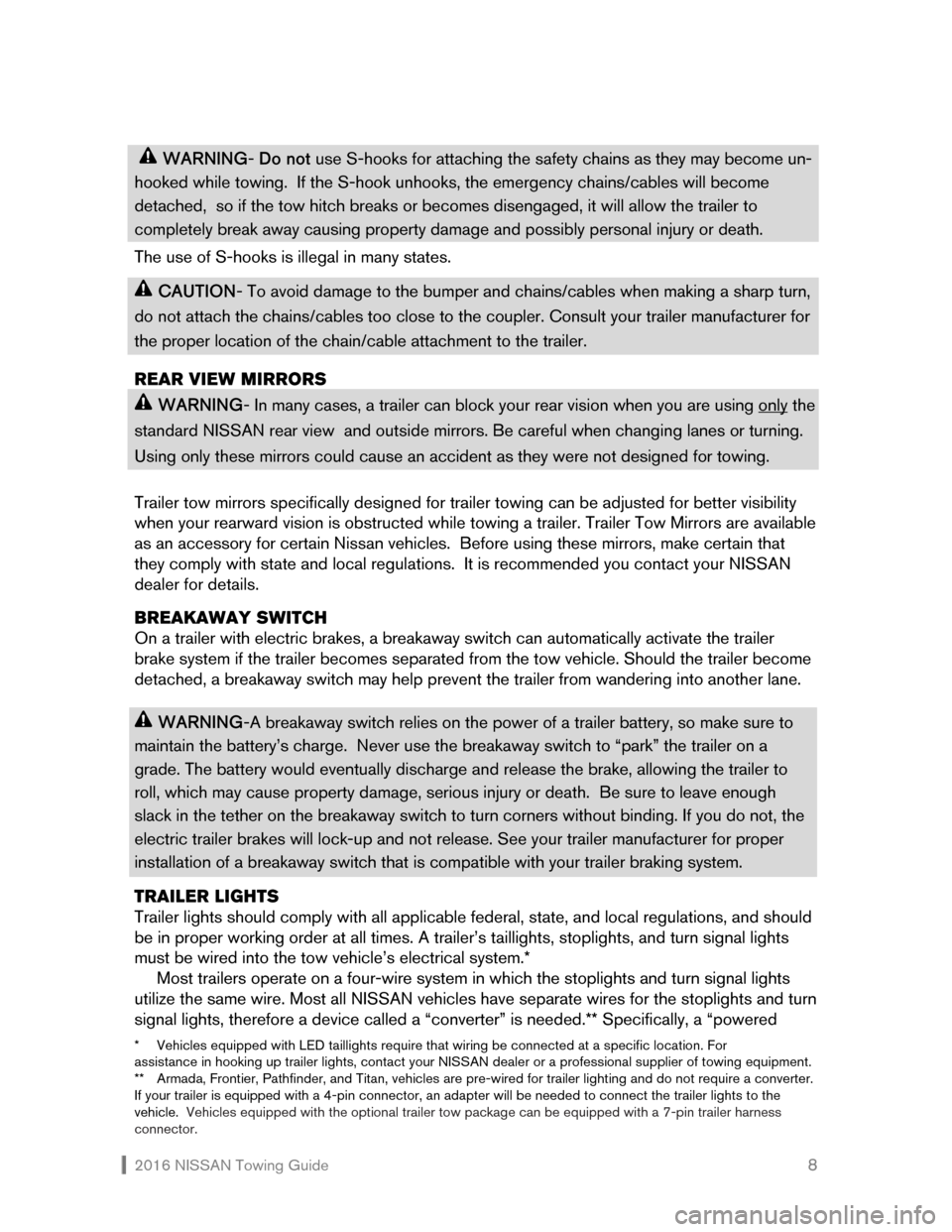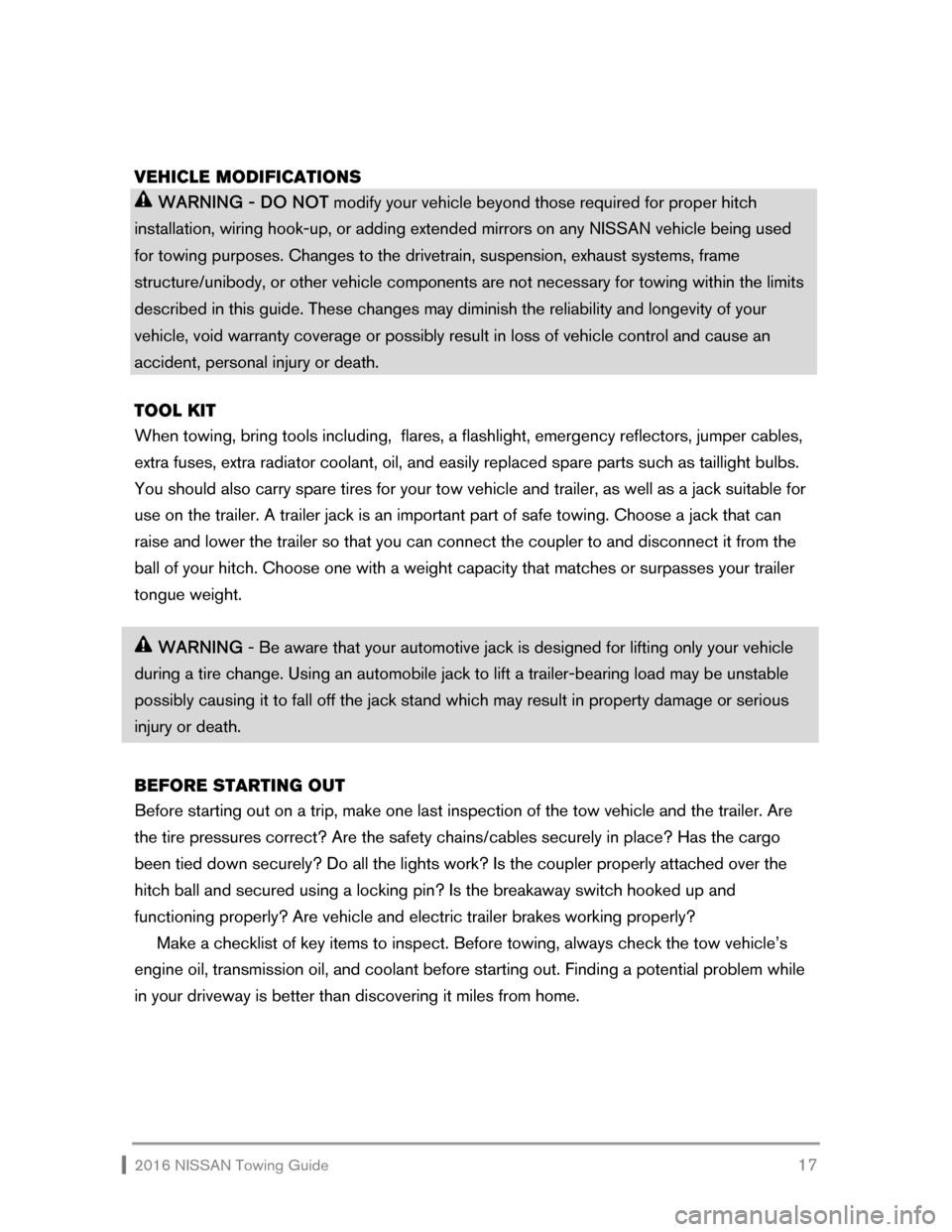mirror NISSAN GT-R 2016 R35 Towing Guide
[x] Cancel search | Manufacturer: NISSAN, Model Year: 2016, Model line: GT-R, Model: NISSAN GT-R 2016 R35Pages: 27, PDF Size: 0.55 MB
Page 9 of 27

2016 NISSAN Towing Guide 8
WARNING- Do not use S-hooks for attaching the safety chains as they may become un-
hooked while towing. If the S-hook unhooks, the emergency chains/cables will become
detached, so if the tow hitch breaks or becomes disengaged, it will allow the trailer to
completely break away causing property damage and possibly personal injury or death.
The use of S-hooks is illegal in many states.
CAUTION- To avoid damage to the bumper and chains/cables when making a sharp turn,
do not attach the chains/cables too close to the coupler. Consult your trailer manufacturer for
the proper location of the chain/cable attachment to the trailer.
REAR VIEW MIRRORS
WARNING- In many cases, a trailer can block your rear vision when you are using only the
standard NISSAN rear view and outside mirrors. Be careful when changing lanes or turning.
Using only these mirrors could cause an accident as they were not designed for towing.
Trailer tow mirrors specifically designed for trailer towing can be adjusted for better visibility
when your rearward vision is obstructed while towing a trailer. Trailer Tow Mirrors are available
as an accessory for certain Nissan vehicles. Before using these mirrors, make certain that
they comply with state and local regulations. It is recommended you contact your NISSAN
dealer for details.
BREAKAWAY SWITCH
On a trailer with electric brakes, a breakaway switch can automatically activate the trailer
brake system if the trailer becomes separated from the tow vehicle. Should the trailer become
detached, a breakaway switch may help prevent the trailer from wandering into another lane.
WARNING-A breakaway switch relies on the power of a trailer battery, so make sure to
maintain the battery’s charge. Never use the breakaway switch to “park” the trailer on a
grade. The battery would eventually discharge and release the brake, allowing the trailer to
roll, which may cause property damage, serious injury or death. Be sure to leave enough
slack in the tether on the breakaway switch to turn corners without binding. If you do not, the
electric trailer brakes will lock-up and not release. See your trailer manufacturer for proper
installation of a breakaway switch that is compatible with your trailer braking system.
TRAILER LIGHTS
Trailer lights should comply with all applicable federal, state, and local regulations, and should
be in proper working order at all times. A trailer’s taillights, stoplights, and turn signal lights
must be wired into the tow vehicle’s electrical system.*
Most trailers operate on a four-wire system in which the stoplights and turn signal lights
utilize the same wire. Most all NISSAN vehicles have separate wires for the stoplights and turn
signal lights, therefore a device called a “converter” is needed.** Specifically, a “powered
* Vehicles equipped with LED taillights require that wiring be connected at a specific location. For
assistance in hooking up trailer lights, contact your NISSAN dealer or a professional supplier of towing equipment.
** Armada, Frontier, Pathfinder, and Titan, vehicles are pre-wired for trailer lighting and do not require a converter.
If your trailer is equipped with a 4-pin connector, an adapter will be needed to connect the trailer lights to the
vehicle. Vehicles equipped with the optional trailer tow package can be equipped with a 7-pin trailer harness
connector.
Page 16 of 27

2016 NISSAN Towing Guide 15
TOWING
SAFETY
Towing can significantly have an effect in altering the handling and performance
characteristics of your vehicle. Moreover, it puts increased strain on the engine and drivetrain.
Therefore, it is always a good idea to approach towing from the standpoint of safety —
whether you are purchasing equipment or actually pulling the trailer. Buy or lease only quality
equipment. You should follow a more frequent maintenance schedule and check fluid levels,
proper tire pressures, tire condition, etc., more often when on the road to protect your vehicle.
WARNING - Always make sure your vehicle’s towing capacity is adequate for the trailer
you intend to tow. Be certain that you have all of the proper equipment needed for safe
towing, such as safety chains/cables, electric trailer brakes, electric trailer brake controller,
breakaway switch, and extended rear view mirrors to help ensure against the possibility of a
serious accident and personal injury or death.
LOADING YOUR TRAILER
WARNING- Taking the time to load and balance your trailer properly, will improve overall
handling and minimize the strain on your tow vehicle. Incorrectly, loaded trailers tend to sway
or swing from side to side, upsetting vehicle handling which could result in a serious accident
and personal injury or death. Careful loading and balancing can help eliminate these
problems.
As mentioned earlier, conventional trailer tongue load must fall between 10-15% of the
total trailer weight, or within the limits of the maximum trailer tongue load specified by the
trailer manufacturer. King pin load — if using a 5th wheel or gooseneck trailer — must be
between 15-25% of the total trailer weight.
WARNING - Excessive tongue/king pin load
can actually push down the tow vehicle in back,
lifting the front wheels to a point where traction,
steering response, and braking may be severely
reduced. Too little tongue/king pin load can
cause instability, which may lead to swaying, “tail
wagging” or jackknifing which could result in a
serious accident or personal injury or death .
With this in mind, proper loading is extremely important. When loading a trailer, 60% of the
total cargo weight should be positioned in the front portion of the trailer and 40% in the back.
Then, adjust the load until the proper tongue/king pin load ratio is achieved.
60%40%
Page 18 of 27

2016 NISSAN Towing Guide 17
VEHICLE MODIFICATIONS
WARNING - DO NOT modify your vehicle beyond those required for proper hitch
installation, wiring hook-up, or adding extended mirrors on any NISSAN vehicle being used
for towing purposes. Changes to the drivetrain, suspension, exhaust systems, frame
structure/unibody, or other vehicle components are not necessary for towing within the limits
described in this guide. These changes may diminish the reliability and longevity of your
vehicle, void warranty coverage or possibly result in loss of vehicle control and cause an
accident, personal injury or death.
TOOL KIT
When towing, bring tools including, flares, a flashlight, emergency reflectors, jumper cables,
extra fuses, extra radiator coolant, oil, and easily replaced spare parts such as taillight bulbs.
You should also carry spare tires for your tow vehicle and trailer, as well as a jack suitable for
use on the trailer. A trailer jack is an important part of safe towing. Choose a jack that can
raise and lower the trailer so that you can connect the coupler to and disconnect it from the
ball of your hitch. Choose one with a weight capacity that matches or surpasses your trailer
tongue weight.
WARNING - Be aware that your automotive jack is designed for lifting only your vehicle
during a tire change. Using an automobile jack to lift a trailer-bearing load may be unstable
possibly causing it to fall off the jack stand which may result in property damage or serious
injury or death.
BEFORE STARTING OUT
Before starting out on a trip, make one last inspection of the tow vehicle and the trailer. Are
the tire pressures correct? Are the safety chains/cables securely in place? Has the cargo
been tied down securely? Do all the lights work? Is the coupler properly attached over the
hitch ball and secured using a locking pin? Is the breakaway switch hooked up and
functioning properly? Are vehicle and electric trailer brakes working properly?
Make a checklist of key items to inspect. Before towing, always check the tow vehicle’s
engine oil, transmission oil, and coolant before starting out. Finding a potential problem while
in your driveway is better than discovering it miles from home.